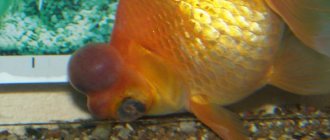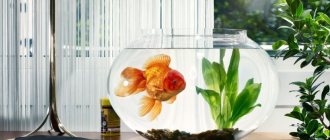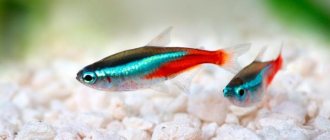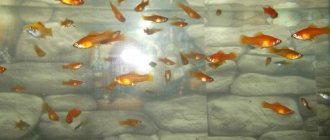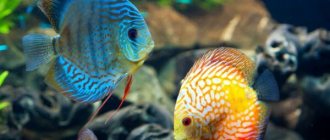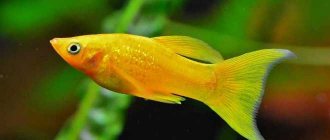The homeland of the goldfish is China, where its ancestors were domesticated back in the 7th century, becoming the progenitors of all types of modern breeds. The first description of a carp with red scales was made in China back in the 3rd century AD. According to statistics, this type of aquarium pet is the most popular all over the world. Various body shapes and fins of fish, as well as colors, were obtained thanks to the work of breeders, which lasted for centuries and continues today.
Description
Body color varies, but most species are red-golden. The abdomen is always lighter than the main color. The goldfish has a round shape, small in length, depending on the specific species, the body is compressed on the sides. The scales can be of different sizes, all individuals have teeth and large gill covers.
The characteristics regarding the shape of the fins and tail of the fish depend on the variety; there are veil-tailed individuals and those with ribbon-like fins, which look impressive while moving in the water. The eyes are usually of a standard size, but the shape of the apples is convex.
For fish to reproduce, a male and a female are needed. There are no viviparous species among goldfish. All fry emerge from eggs.
Such an individual will look good in any aquarium and will decorate every artificial reservoir. Every aquarist should have at least one goldfish in his collection, thanks to its unusual beautiful appearance.
Dimensions
The fish grow in an aquarium to small sizes; as a rule, the length of the body without a tail is no more than 15 cm. In large reservoirs, the golden individual grows better and can reach 40 cm. The length of the fins varies significantly depending on the species. By creating good conditions for keeping goldfish, healthy and active growth of the individual is ensured.
Life expectancy also depends on size. The shortest individuals live less, within 15 years, while long-bodied representatives can live up to 40 years.
Motherland
Aquarium goldfish are a type of freshwater fish, bred in artificial conditions, belonging to the genus of crucian carp. They were first bred in the East, so the birthplace of goldfish is China and Korea.
Breeding goldfish
The most suitable time for breeding goldfish is the age of 2-4 years. An aquarium of about 30-40 liters is suitable for spawning. A couple of males and one female are placed there. When a female is ready to spawn, her abdomen becomes larger than usual.
To avoid eating eggs, a net is installed in the spawning area or plants are placed. The male begins to actively chase the female, driving her into the thick of plants. This process takes from 2 to 5 hours. Then the fish are removed. After 2-6 days, the fry appear. The first food may be rotifers, “live dust” or Artemia nauplii.
If you find an error, please select a piece of text and press Ctrl+Enter.
Varieties
Selective breeding has achieved great results; the goldfish family has about 300 varieties. Goldfish differ in color, shape, size and type of fins.
The most popular types of breeds:
- Ordinary. Contained in indoor aquariums and open containers, the color of the scales is red-orange, the body length reaches 40 cm.
- Veiltail. It has a long tail fin and enlarged eyeballs, and is calm and leisurely.
- Fish telescope. A distinctive feature is large eyes; the shape of the eyeballs differs depending on the species.
- Jikin butterfly. The fin has a forked shape, reminiscent of butterfly wings. Representatives are only divorced at home.
- Ranchu. It is distinguished by a flattened body and small fins; there are no fins on the back.
- Ryukin. It has a curved back and is extremely slow in its movements. Loves warm conditions.
- Oranda. Outwardly it resembles a telescope, but on the forehead it has a fatty growth in the form of a golden cap.
- Bubble Eye. The fish has characteristic bags around the eyes, which are filled with liquid; their size can reach 25% of the size of the entire fish.
- Pecilia. It has a diamond-shaped body and a wide caudal fin, the head is small compared to the body. The most popular species for keeping in home reservoirs.
№6
They typically have a brownish tint at birth. They acquire the famous “golden” hue as they grow older. However, under certain conditions, their color may fade. For example, they need enough sunlight (you can use a special lamp). With a lack of sunlight, they may begin to turn white. They also change color as they age.
Volume and shape of the aquarium
Goldfish bred artificially in special ponds are not adapted to life in containers that are too small. An aquarium with goldfish must be at least 80 liters. With a smaller volume, the pet will not have enough space for movement and active life. By creating the most optimal housing conditions, ensuring high-quality filtration and aeration, the volume per individual can be reduced to 40 liters.
When choosing the shape of a container, it is preferable to choose a classic rectangular one or with a slight curvature of the front wall of the aquarium, and the length of the vessel should be at least twice the height.
It is important to take into account that high vessels such as screens and cylinders are not suitable for keeping goldfish, since the water height should be within 40 cm. It is not recommended to keep a pet in a round aquarium, since the conditions created in such a container significantly reduce the duration life of an individual.
The requirements for keeping an aquarium are the same as for keeping many other types of fish. The substrate should not be too fine so that the fish do not choke on its particles when digging. The particles should be smooth without sharp edges. Large decorative elements are not recommended for placement in a vessel, since golden individuals do not require a place to hide; excess decor interferes with free swimming and can be a danger to the large fins of many species.
Water parameters
Goldfish do not require special housing conditions. Her main need is space to move. Requirements for the characteristics of water inside an artificial reservoir:
- Temperatures can vary from 20 to 25 degrees.
- Acidity from 6.9 to 7.2.
- Water hardness can be no lower than 8.
The temperature of the aquatic environment can fluctuate significantly and depend on the species of individual. The golden crucian carp is cold-blooded and can tolerate low temperatures without sudden changes. Temperatures between 22–24 degrees are optimal for active games. Long-bodied individuals prefer lower temperatures than short representatives. Decorative species are considered the most heat-loving.
Filtration and water changes
A goldfish aquarium must be thoroughly cleaned due to the following factors:
- Individuals love to rummage through the substrate and pick up mud from the bottom.
- Fish excrement is a mucus that contributes to soil rotting.
To eliminate all the consequences of its life activity, you need a filter with a capacity of at least 3 volumes of water per hour.
A number of actions need to be performed:
- Wash the filter sponges in aquarium water once a week.
- Siphon the substrate once a week, being careful to prevent mixing of the layers.
- Water should be changed frequently, on average once a week.
- It is enough to let the water change stand for 24 hours.
An aerator is required, or it must be on the filter. If the internal space in the aquarium is properly organized, there are a large number of plants, sufficient lighting and an additional supply of carbon dioxide, the aerator can only be turned on at night.
Aquarium plants
Keeping goldfish in an aquarium requires the presence of live plants inside the reservoir. Plants must be present to perform a number of functions:
- Nitrogen consumption.
- Substrate for bacteria.
- Vitamin supplement for the inhabitants.
Depending on the conditions in your goldfish's habitat, there may be active algae growth. Since pets love to eat plants, it is recommended that some of the plantings be used for feeding, and some should be planted to decorate the space and create biological balance. Plants with hard leaves are better suited.
Plants should be planted in pots to protect the roots from damage during digging, which fish like to do.
How to care
Goldfish are unpretentious individuals; care and maintenance must be regular. Goldfish need clean water, they tolerate fresh water well, with a short settling time. Features of the content are related to the life activity of the individual. Due to the active growth of algae inside the reservoir, they should be removed and the container glass should be regularly cleaned of them. Plants need to be thinned and pruned once a week.
Keeping goldfish does not require complex and unusual procedures; the manipulations consist of maintaining regular cleanliness inside the reservoir to ensure a quality life for pets.
Feeding
Not only caring for goldfish requires attention and a responsible attitude on the part of the owner. Feeding golden individuals also requires that all necessary conditions be met. At home, the fish should be fed 2 times a day, the volume should be such that the duration of the meal is no more than 5 minutes. Overeating is deadly.
Feeding is varied; dry food should be alternated with plant foods; regardless of the food, it must be prepared in advance. Thaw frozen food and soak dry food granules in aquarium water.
Plant food can be used:
- Spinach.
- Boiled vegetables and cereals.
- Fruits.
- Meat and liver.
- Bloodworm.
It is better to regularly feed your pets with live daphnia, which will serve as additional feeding. You can grow Daphnia yourself. Living plants inside the vessel will also be an additional source of essential nutrients. To maintain health, it is recommended to do a fasting day once a week.
Feeding the goldfish
These fish are classified as omnivorous species; they do not refuse any food. A proper diet for a goldfish should include both plant and animal components. Their appetite is very good, but these fish cannot be overfed. It is better to feed them twice a day, alternating different types of food.
Dry food in the form of flakes, granules or sticks often contains various additives that make the color of the fish brighter and more saturated. When choosing this type of food, preference is given to products designed specifically for goldfish.
One of the outdated names for “goldfish” was “golden carp”.
Who does he get along with?
Goldfish prefer to live with similar individuals. It is also not recommended to place fish of different body lengths in one vessel. Different species differ not only in body size, but also in character.
If golden representatives are placed with other species of fish, there will be a risk of damage to the fins, since golden individuals need a lot of space. There are species of fish that are very small in size, so goldfish can easily eat them.
Despite the fact that goldfish are peaceful fish, it is important to know that combining them with other species reduces their life expectancy and health. As a result, compatibility with other fish becomes a difficult task.
